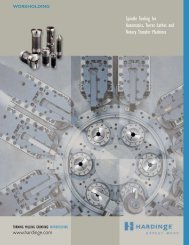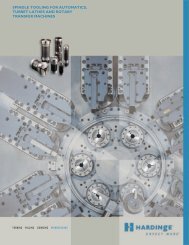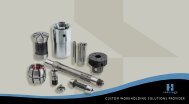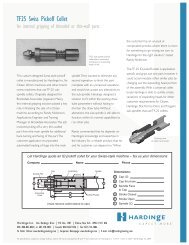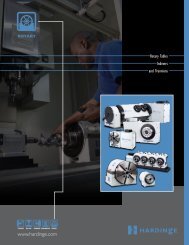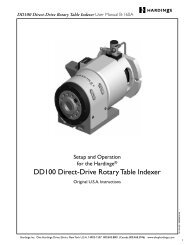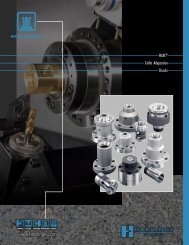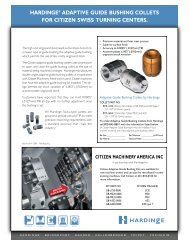Hardinge Tool Holders, Toolholder Collets and Bushings Catalog ...
Hardinge Tool Holders, Toolholder Collets and Bushings Catalog ...
Hardinge Tool Holders, Toolholder Collets and Bushings Catalog ...
You also want an ePaper? Increase the reach of your titles
YUMPU automatically turns print PDFs into web optimized ePapers that Google loves.
Frequently Asked Questions<br />
"I’m using a small diameter split drill bushing <strong>and</strong> I can’t seem to get the drill<br />
parallel to the centerline of the spindle. Why?"<br />
• A common cause for this problem is locking the second set screw on the<br />
bushing. The holes for small diameter drills do not extend the full length of the<br />
bushing. The back end of the bushing usually has a large internal chamfer or<br />
a counterbore. This cleared area is under the second lock screw. When you<br />
tighten this screw, the bushing may distort, shifting the drill’s position. There<br />
may be line contact on which the drill will pivot. The solution is to use the front<br />
locking screw only.<br />
• A second cause is that the bushing is too short. The first set screw is locking<br />
on the back of the bushing, causing it to collapse instead of gripping the shank<br />
of the tool.<br />
"I am trying to drill a very accurate hole using a DA-style collet system without<br />
any success. Any suggestions?"<br />
• Extremely accurate drilling requires a very good holder <strong>and</strong> collet. With the<br />
considerable flexibility of the DA, TG <strong>and</strong> ER collets, we tend to forget the<br />
cardinal rule for collets – the bore of the collet should be the exact size of<br />
the diameter being gripped for the best TIR <strong>and</strong> gripping force. Therefore, for<br />
extremely accurate drilling, the collet bore should be the same size as the shank<br />
of the drill.<br />
• Second, if you have a choice of holders, it is best to use the ER collet holder<br />
over the DA collet holder. The DA holder is a double-angle holder with a closing<br />
angle on the front <strong>and</strong> back of the collet. The theory is that the collet will<br />
close parallel to the centerline of the holder. Unfortunately, it is very difficult<br />
to manufacture a holder <strong>and</strong> collet that accurately mate. For st<strong>and</strong>ard drilling<br />
tolerances, this usually is not a problem, but can be when doing extremely close<br />
tolerance drilling.<br />
The ER is considered a single-angle collet because the major closing angle is long<br />
<strong>and</strong> shallow. This results in better concentricity than the double-angle system.<br />
The TG collet system is better than the ER system because it has an even<br />
shallower closing angle. Unfortunately, this system is usually for larger shanks <strong>and</strong><br />
most holders that use these collets are for vertical machining centers.<br />
• For extremely accurate drilling, the bore of the collet should be the exact size<br />
of the shank of the drill.<br />
"I’ve tried rigid tapping using st<strong>and</strong>ard ER collets in my non-floating holders <strong>and</strong> I’m<br />
breaking taps. Why is this happening <strong>and</strong> is there a reasonably-priced solution?"<br />
• Taps may be breaking because your machine tool may not be designed for<br />
rigid tapping, you did not buy that option, or there is a small error between<br />
the spindle reversal <strong>and</strong> slide reversal. These are machine tool problems that<br />
?<br />
www.Shop HARDINGE.com<br />
you can work around without disassembling the<br />
machine. Use a floating tap collet such as the<br />
ERQC or the ERTC. These collets fit in the<br />
st<strong>and</strong>ard rigid holder <strong>and</strong> will float longitudinally.<br />
• If you want to continue to use your current collets,<br />
floating tap holders are available. These holders<br />
are longer than the st<strong>and</strong>ard holders <strong>and</strong> more<br />
expensive than the floating tap collets.<br />
"The TIR of the drill being held in my ER collet is<br />
excessive. What TIR can I expect from a st<strong>and</strong>ard<br />
ER collet?"<br />
• Quick fix — if you are using a ball bearing cap<br />
on your ER holder, change it to a one-piece<br />
cap. The ball bearing cap allows you to use<br />
more torque when gripping solid floating tap<br />
collets, but when used for drilling, the TIR is not as<br />
accurate as the one-piece cap.<br />
• All of our ER collets are made to the DIN 6499<br />
specification. Refer to page 12 for the acceptable<br />
TIR for your collet. When checking the collet <strong>and</strong><br />
holder, use a certified gauge plug. First, indicate the<br />
seat of the holder, then assemble collet <strong>and</strong> gauge<br />
plug <strong>and</strong> indicate the plug at the "L" dimension.<br />
Make corrections for holder seat runout (the most<br />
accurate check is to use a coordinate measuring<br />
system – most indicators do not give a true reading<br />
when rotating 360° from the lathe spindle). If this<br />
checks out within specifications, check the gauge<br />
pin at the actual drill length, which may be longer<br />
than the "L" dimension. If the TIR at this point is too<br />
great, you will have to acquire a higher precision<br />
collet such as the ERNC. If you’re using a metric<br />
bushing to hold a fractional drill, a more reasonable<br />
solution would be to acquire an inch series collet<br />
for the exact shank of your drill.<br />
"I am using an ER Collet in a high-speed spindle <strong>and</strong><br />
am getting vibration that I don’t get with my other<br />
holders. What’s wrong?"<br />
• You’re probably using a st<strong>and</strong>ard one-piece cap.<br />
Acquire a one-piece cap that has a ring to hold<br />
the collet instead of the st<strong>and</strong>ard cap that has an<br />
eccentric slot. The eccentricity of the groove will<br />
cause an out-of-balance condition at high rpm. If<br />
this does not eliminate the vibration, the complete<br />
assembly will have to be precision balanced in<br />
relation to the RPM you’re running.<br />
<strong>Hardinge</strong> Inc. | 800.843.8801 | www.shophardinge.com <strong>Tool</strong>holder <strong>Collets</strong>, <strong>Bushings</strong> & <strong>Tool</strong> <strong>Holders</strong>—47



